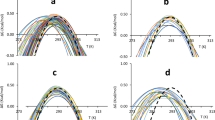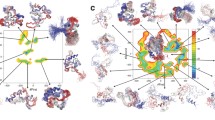Abstract
Understanding protein stability at residue level detail in the native state ensemble of a protein is crucial to understanding its biological function. At the same time, deriving thermodynamic parameters using conventional spectroscopic and calorimetric techniques remains a major challenge for some proteins due to protein aggregation and irreversibility of denaturation at higher temperature values. In this regard, we describe here the NMR investigations on the conformational stabilities and related thermodynamic parameters such as local unfolding enthalpies, heat capacities and transition midpoints in DLC8 dimer, by using temperature dependent native state hydrogen exchange; this protein aggregates at high (>65°C) temperatures. The stability (free energy) of the native state was found to vary substantially with temperature at every residue. Significant differences were found in the thermodynamic parameters at individual residue sites indicating that the local environments in the protein structure would respond differently to external perturbations; this reflects on plasticity differences in different regions of the protein. Further, comparison of this data with similar data obtained from GdnHCl dependent native state hydrogen exchange indicated many similarities at residue level, suggesting that local unfolding transitions may be similar in both the cases. This has implications for the folding/unfolding mechanisms of the protein.





Similar content being viewed by others
References
Bai Y, Milne JS, Mayne L, Englander SW (1993) Primary structure effects on peptide group hydrogen exchange. Proteins 17:75–86
Bai Y, Milne JS, Mayne L, Englander SW (1994) Protein stability parameters measured by hydrogen exchange. Proteins 20:4–14
Bai Y, Sosnick TR, Mayne L, Englander SW (1995) Protein folding intermediates: native-state hydrogen exchange. Science 269:192–197
Barbar E, Kleinman B, Imhoff D, Li M, Hays TS, Hare M (2001) Dimerization and folding of LC8, a highly conserved light chain of cytoplasmic dynein. Biochemistry 40:1596–1605
Becktel WJ, Schellman JA (1987) Protein stability curves. Biopolymers 26:1859–1877
Brorsson AC, Kjellson A, Aronsson G, Sethson I, Hambraeus C, Jonsson BH (2004) The “two-state folder” MerP forms partially unfolded structures that show temperature dependent hydrogen exchange. J Mol Biol 340:333–344
Chamberlain AK, Marqusee S (1997) Touring the landscapes: partially folded proteins examined by hydrogen exchange. Structure 5:859–863
Chi YH, Kumar TK, Chiu IM, Yu C (2002) Identification of rare partially unfolded states in equilibrium with the native conformation in an all beta-barrel protein. J Biol Chem 277:34941–34948
Chu R, Pei W, Takei J, Bai Y (2002) Relationship between the native-state hydrogen exchange and folding pathways of a four-helix bundle protein. Biochemistry 41:7998–8003
Dill KA (1990) Dominant forces in protein folding. Biochemistry 29:7133–7155
Dyson HJ, Wright PE (1996) Insights into protein folding from NMR. Annu Rev Phys Chem 47:369–395
Fuhrmann JC, Kins S, Rostaing P, El FO, Kirsch J, Sheng M, Triller A, Betz H, Kneussel M (2002) Gephyrin interacts with Dynein light chains 1 and 2, components of motor protein complexes. J Neurosci 22:5393–5402
Hoang L, Bedard S, Krishna MM, Lin Y, Englander SW (2002) Cytochrome c folding pathway: kinetic native-state hydrogen exchange. Proc Natl Acad Sci USA 99:12173–12178
Honig B (1999) Protein folding: from the levinthal paradox to structure prediction. J Mol Biol 293:283–293
Hvidt A, Nielsen SO (1966) Hydrogen exchange in proteins. Adv Protein Chem 21:287–386
Jaffrey SR, Snyder SH (1996) PIN: an associated protein inhibitor of neuronal nitric oxide synthase. Science 274:774–777
Kamal JK, Nazeerunnisa M, Behere DV (2002) Thermal unfolding of soybean peroxidase. Appropriate high denaturant concentrations induce cooperativity allowing the correct measurement of thermodynamic parameters. J Biol Chem 277:40717–40721
Kauzmann W (1959) Some factors in the interpretation of protein denaturation. Adv Protein Chem 14:1–63
Krishna Mohan PM (2007) Unfolding energetics and conformational stability of DLC8 monomer. Biochimie 89:1409–1415
Krishna Mohan PM, Hosur RV (2007) NMR insights into dynamics regulated target binding of DLC8 dimer. Biochem Biophys Res Commun 355:950–955
Krishna Mohan PM, Barve M, Chatterjee A, Ghosh-Roy A, Hosur RV (2008) NMR comparison of the native energy landscapes of DLC8 dimer and monomer. Biophys Chem 134:10–19
Krishna MM, Hoang L, Lin Y, Englander SW (2004) Hydrogen exchange methods to study protein folding. Methods 34:51–64
Liang J, Jaffrey SR, Guo W, Snyder SH, Clardy J (1999) Structure of the PIN/LC8 dimer with a bound peptide. Nat Struct Biol 6:735–740
Linderstrøm-Lang K (1958) Deuterium exchange and protein structure. In: Neuberger (ed) Symposium on protein structure, London
Lo KW, Kan HM, Chan LN, Xu WG, Wang KP, Wu Z, Sheng M, Zhang M (2005) The 8-kDa dynein light chain binds to p53-binding protein 1 and mediates DNA damage-induced p53 nuclear accumulation. J Biol Chem 280:8172–8179
Lopez MM, Makhatadze GI (2002) Differential scanning calorimetry. Methods Mol Biol 173:113–119
Maity H, Maity M, Krishna MM, Mayne L, Englander SW (2005) Protein folding: the stepwise assembly of foldon units. Proc Natl Acad Sci USA 102:4741–4746
Mohan PM, Hosur RV (2008a) NMR characterization of structural and dynamics perturbations due to a single point mutation in Drosophila DLC8 dimer: functional implications. Biochemistry 47:6251–6259
Mohan PM, Hosur RV (2008b) pH dependent unfolding characteristics of DLC8 dimer: residue level details from NMR. Biochim Biophys Acta 1784:1795–1803
Mohan PM, Barve M, Chatterjee A, Hosur RV (2006) pH driven conformational dynamics and dimer-to-monomer transition in DLC8. Protein Sci 15:335–342
Mohan PM, Chakraborty S, Hosur RV (2009a) Residue-wise conformational stability of DLC8 dimer from native-state hydrogen exchange. Proteins 75(1):40–52
Mohan PM, Joshi MV, Hosur RV (2009b) Hierarchy in guanidine unfolding of DLC8 dimer: regulatory functional implications. Biochimie 91(3):401–407
Mukherjee S, Mohan PM, Kuchroo K, Chary KV (2007) Energetics of the native energy landscape of a two-domain calcium sensor protein: distinct folding features of the two domains. Biochemistry 46:9911–9919
Pace CN (1975) The stability of globular proteins. CRC Crit Rev Biochem 3:1–43
Pace CN (1986) Determination and analysis of urea and guanidine hydrochloride denaturation curves. Methods Enzymol 131:266–280
Pace CN, Shirley BA, McNutt M, Gajiwala K (1996) Forces contributing to the conformational stability of proteins. FASEB J 10:75–83
Privalov PL, Khechinashvili NN (1974) A thermodynamic approach to the problem of stabilization of globular protein structure: a calorimetric study. J Mol Biol 86:665–684
Puthalakath H, Villunger A, O’Reilly LA, Beaumont JG, Coultas L, Cheney RE, Huang DC, Strasser A (2001) Bmf: a proapoptotic BH3-only protein regulated by interaction with the myosin V actin motor complex, activated by anoikis. Science 293:1829–1832
Rose GD, Wolfenden R (1993) Hydrogen bonding, hydrophobicity, packing, and protein folding. Annu Rev Biophys Biomol Struct 22:381–415
Rumbley J, Hoang L, Mayne L, Englander SW (2001) An amino acid code for protein folding. Proc Natl Acad Sci USA 98:105–112
Shih P, Holland DR, Kirsch JF (1995) Thermal stability determinants of chicken egg-white lysozyme core mutants: hydrophobicity, packing volume, and conserved buried water molecules. Protein Sci 4:2050–2062
Song Y, Benison G, Nyarko A, Hays TS, Barbar E (2007) Potential role for phosphorylation in differential regulation of the assembly of dynein light chains. J Biol Chem 282:17272–17279
Stowell MH, Rees DC (1995) Structure and stability of membrane proteins. Adv Protein Chem 46:279–311
Vadlamudi RK, Bagheri-Yarmand R, Yang Z, Balasenthil S, Nguyen D, Sahin AA, den HP, Kumar R (2004) Dynein light chain 1, a p21-activated kinase 1-interacting substrate, promotes cancerous phenotypes. Cancer Cell 5:575–585
Zipp A, Kauzmann W (1973) Pressure denaturation of metmyoglobin. Biochemistry 12:4217–4228
Acknowledgments
We thank Government of India for providing financial support to the National Facility for High Field NMR at the Tata Institute of Fundamental Research. The authors acknowledge Dr. Anindya Ghosh-Roy for the DLC8 clone, Dr. M. M. G Krishna for HX Excel spread sheet, and Dr. Sulakshana Mukherjee for critical comments. PMKM is a recipient of TIFR Alumni Association Scholarship (2003–2005) and Sarojini Damodaran International Fellowship for career development, supported by the TIFR endowment fund.
Author information
Authors and Affiliations
Corresponding author
Electronic supplementary material
Below is the link to the electronic supplementary material.
Rights and permissions
About this article
Cite this article
Krishna Mohan, P.M., Chakraborty, S. & Hosur, R.V. NMR investigations on residue level unfolding thermodynamics in DLC8 dimer by temperature dependent native state hydrogen exchange. J Biomol NMR 44, 1–11 (2009). https://doi.org/10.1007/s10858-009-9311-5
Received:
Revised:
Accepted:
Published:
Issue Date:
DOI: https://doi.org/10.1007/s10858-009-9311-5




